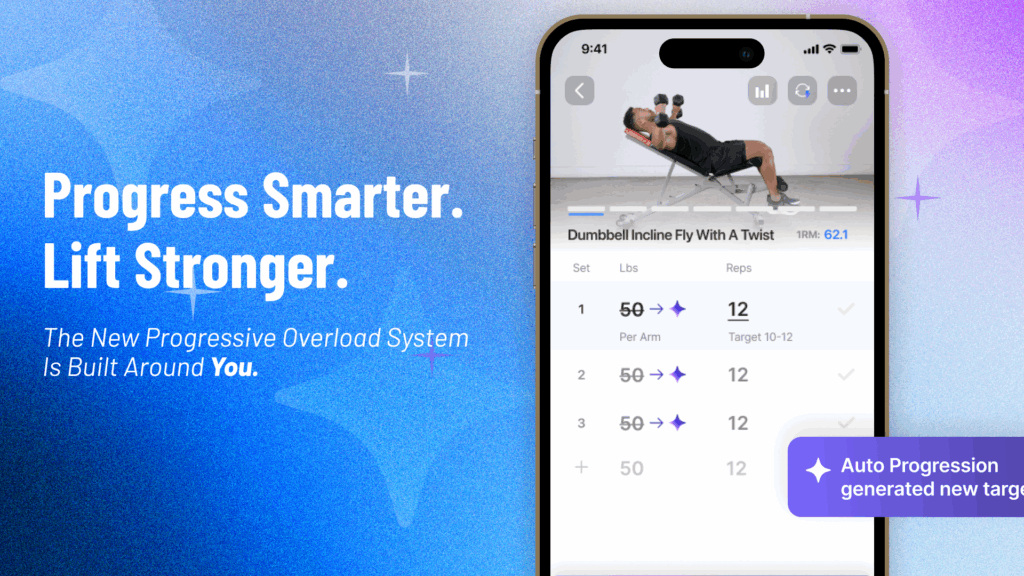Smarter. Adaptive. Designed Around You.
For over a decade, Jefit has helped millions of lifters track their workouts and celebrate progress.
Now, we’re taking the next leap forward — transforming Jefit from a workout tracker into a deeply personalized training intelligence.
Introducing the Progressive Overload (PO) System — Jefit’s most advanced evolution yet.
A system that doesn’t just record what you do, but understands how you train, adapts to your performance, and helps you reach your goals with unmatched precision.
This is training built around you.
Table of contents
Why we built
Meet the AI-Powered Progressive Overload System
How the System Works
The Three Core Engines Behind the PO System
EMG-Driven Training Intelligence
Adaptive Feedback
Launch Timeline: Stage 1 and Beyond
In short
Why We Built the PO System
Every lifter adapts differently — pace, recovery, strength gains, and stimulus needs all vary. Static programs can’t account for that, which is why they stop working. The PO System is built to adapt. It’s a goal-driven progression engine that reads your actual training data and adjusts the key variables that matter most for long-term progress:
- how much weight you should lift
- how much effective stimulus you need
- how balanced your movement patterns are
- how much recovery your body signals
You log your workouts the same way. The system simply interprets your response and gives you the next best step — personalized, data-grounded, and always aligned with your goal.
Meet the AI-Powered Progressive Overload System
JEFIT’s Progressive Overload (PO) System takes a structured approach to adaptive training. It begins with your goal, then lays out a clear multi-week blueprint built around four purposeful phases: foundation, intensification, peak, and recovery. As you log your workouts, the system reads your actual performance and adjusts your load targets, weekly volume, and movement balance — keeping your progression aligned with how your body is responding, week after week. Instead of generating workouts at random, it uses 15 years of real training data to guide structured, long-term progression. The result is adaptation that’s consistent, intentional, and personal. Before we go deeper, here’s how it compares to common AI-based workout approaches:
| Capability | Common “AI Workout Apps” | Jefit’s AI-Powered PO System |
|---|---|---|
| Training Structure | Week-to-week generated workouts | Structured multi-week mesocycles(foundation → intensification → peak → recovery) |
| Progression Logic | General or reactive adjustments | AI-powered, data-driven weekly progression(load / volume / balance) |
| Stimulus Understanding | Counts sets & reps uniformly | HSE + EMG-based modeling to read true training impact |
How the System Works
The Three Core Engines Behind the PO System
Decide What Gets Adjusted
The PO System operates through three adaptive engines that work together inside your North Star Progress Index (NSPI) dashboard:

- Strength Engine → adjusts load progression
- Stimulus Engine → adjusts total Hard-Set Equivalents (HSE)
- Movement Balance Engine → adjusts movement ratios (push/pull, squat/hinge)
These three engines feed into your NSPI score — a single, unified view of how your body is responding to training, personalized to your goal and experience level.
EMG-Driven Training Intelligence
he Data Layer — How the System Knows What to Adjust
The PO System is built on 15 years of JEFIT training data, combined with a research-grade EMG activation map. To measure the true quality of each set, the system converts your logs into Hard-Set Equivalents (HSE) — a stimulus metric based on:
- muscle activation intensity (EMG)
- load relative to your strength capacity
- effort level (proximity to failure)
- exercise role (primary vs accessory)
Together, these inputs show how much your training actually stimulated your muscles — allowing the system to adjust load, volume, and balance with precision.
Adaptive Feedback
How system evolves with you
The PO System learns from every session and adjusts automatically:
- rising strength trends → higher load targets
- excessive stimulus volume → smarter tapering
- drifting movement ratios → restored balance
Over time, the system becomes uniquely yours — because no two lifters adapt the same way.
Launch Timeline: Stage 1 and Beyond
The Progressive Overload System is rolling out in stages — each expanding how much of your training the system can adapt for you.
Stage 1 → Strength Engine (Now Live)
Intelligent load progression integrated into NSPI, helping you see when to increase, consolidate, or pull back.
Stage 2 → Mesocycle Adaptation (Coming Soon)
Goal-specific training blocks that adjust weekly based on your real performance — bringing full plan-level adaptation to Jefit.
Beyond →A Self-Evolving Training System
From here, the PO System will continue to evolve. Its learning engine improves continuously, using aggregated data from millions of workouts to refine personalization and prediction accuracy. Jefit’s goal isn’t to remove effort — it’s to make every click more valuable.
By turning your training logs into adaptive intelligence, Jefit helps you lift with purpose, clarity, and confidence.
This is the future of workout tracking:
not replacing the lifter, but amplifying the lifter through systems that evolve with them.
In short
The Ai Powered Progressive Overload System is Jefit’s next major step forward — a personalized, adaptive training model that learns from your data and adjusts every week to keep you progressing efficiently. It reads your logged workouts, understands how your body responds, and turns that into structured, data-driven guidance.
No templates. No guesswork.
Just a system that gets smarter with every rep you log. You still train the same way.
But now, every log becomes feedback — and every week, the system helps you train with greater clarity and purpose.
The future of fitness isn’t about doing more.
It’s about doing exactly what moves you forward.
Try the PO System today — and see how adaptive training feels when it’s built around you.
- The Science Behind Jefit’s Load Progression Engine - November 20, 2025
- The Stimulus Volume Engine - November 19, 2025
- The Movement Balance Engine - November 19, 2025
